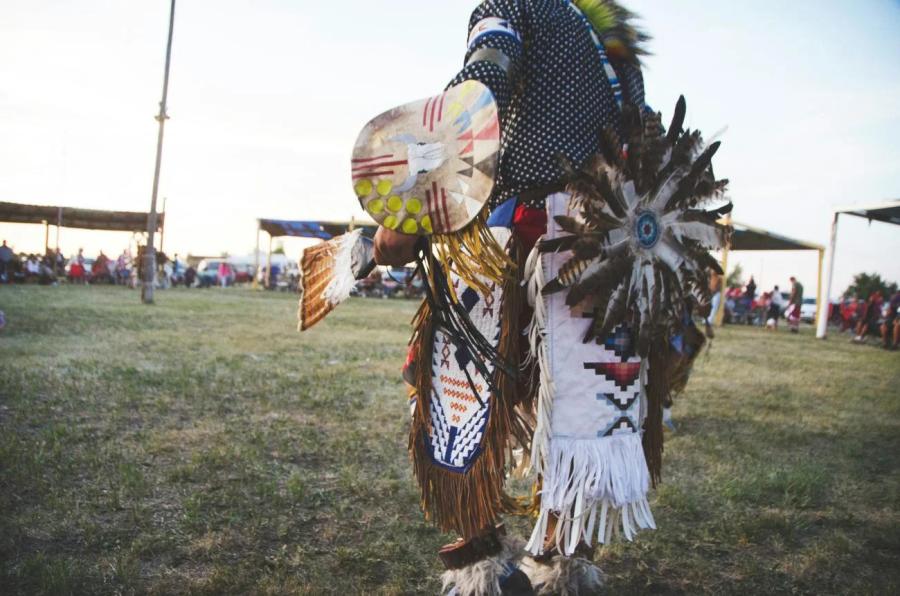By Chenae Bullock (Shinnecock)
I come from a long line of wisdom keepers of their generations. Although I am enrolled in the Shinnecock Nation, I am a living descendant of the people who lived throughout Long Island and New England and whose laws predate the Doctrine of Discovery. After a lifetime of working with my Elders and teachers learning my lineage and oral history, I recognize my inherent obligation to preserve the culture, land, and identity we have lived for over 500 years. It is with this ancient wisdom that has been passed down to me that I have chosen to use Indigenopathic medicine to heal the layers of trauma that have been caused by the Europeans’ belief that they have dominion over the spirit of my Peoples. Healing my trauma has involved a layered approach involving cultural ceremonies that address the various dimensions of my own experience as well as the collective memories of my ancestral lineage. Healing and integrating these experiences into my identity and life story helps me move forward and work to serve my community. This approach to healing recognizes that trauma affects individuals holistically and is often incomprehensible to the western colonially indoctrinated belief system.
The full history of the Shinnecock Peoples’ fight to protect and preserve their land is extensive and is part of a broader context of Indigenous Peoples' struggles for land and sovereignty in the United States. I often think deeply about the different approaches my ancestors had to take for the survival of a People. Contrary to the history written by Europeans and the perpetuation of their stories, my ancestors did not always see eye-to-eye in dealing with colonial affairs. As I reflect on my ancestry, I am reminded of the complex history of my people. My family tree boasts a lineage of sachems and sunk squas (male and female chiefs, respectively), a few of whom became divided due to conflicting approaches to leadership. This has led me to delve deeper into the insidious effects of historical, generational, and present-day trauma that have plagued my community for generations, and I have dedicated myself to understanding and healing these wounds.
Montaukett delegation to Washington D.C. in 1921. Photo from the Pharaoh Family of Montaukett.
Among my ancestors, there were those who held opposing viewpoints, such as Miantonomi and Wyandanch; Ninigret and Wyandanch; Piggaticutt and Wyandanch, and Uncas and Sassacus. These individuals were interrelated with the Shinnecock, Montauk, Pequot, and Narragansett Tribes. Wyandanch, in particular, appears to have provoked a great deal of controversy among his relatives due to his perceived friendliness with settlers during genocidal events. My understanding of these leaders’ differing perspectives comes from both oral history and my own experiences witnessing similar patterns continuing to play out within our Tribal communities to this day.
Mongotucksee (1550-1610), an antecedent of my grandfather who was known as permanent sachem in what is now Montauk, Long Island, and his extended relative, Miantonomi (1600–1643), a well-known sachem of the Narragansett Peoples in New England, knew their roles as hereditary chiefs so much so that they refused to interface with the colonists and would only deal directly with the Crown. Miantonomi knew that his relatives in Montauk shared the same blood and cultural customs, and he came to Montauk in the 1640s to talk about reuniting the families that had been divided by the colonists. It is interesting that Wyandanch, who was one of the sons of Mongotucksee, became highly favored by the English and informed the English of the alliance that Miantonomi was trying to form with the New England and Long Island tribes. Though we are now in a vastly different time period, the dividing of our People continues because we are all continually pressured to let go of who we are.
The Shinnecock and other Tribes have always had societal structures, kinship clan systems, clan mothers within their governance structures, and wampum belts that commemorated and bound our religions, Tribal laws, rights of passage, covenants, agreements, and oaths. Despite more than 500 years of attempts to erase any trace of our existence, resiliency is in our genetic makeup, and we have been able to maintain and revitalize our cultural existence. For example, the concept of buying and selling land has always been foreign to us. We allowed people to use the land by coming to an agreement to share or lease it, but we never sold the land. We have respect for all life, which is why we agreed to live in peace. There is evidence for these claims in the Treaty of Plymouth, the Conscience Point agreement, and others. To experience the settler colonialism that is a perpetuation of the Doctrine of Discovery in the same lands that we have always been in is incomprehensible to us.
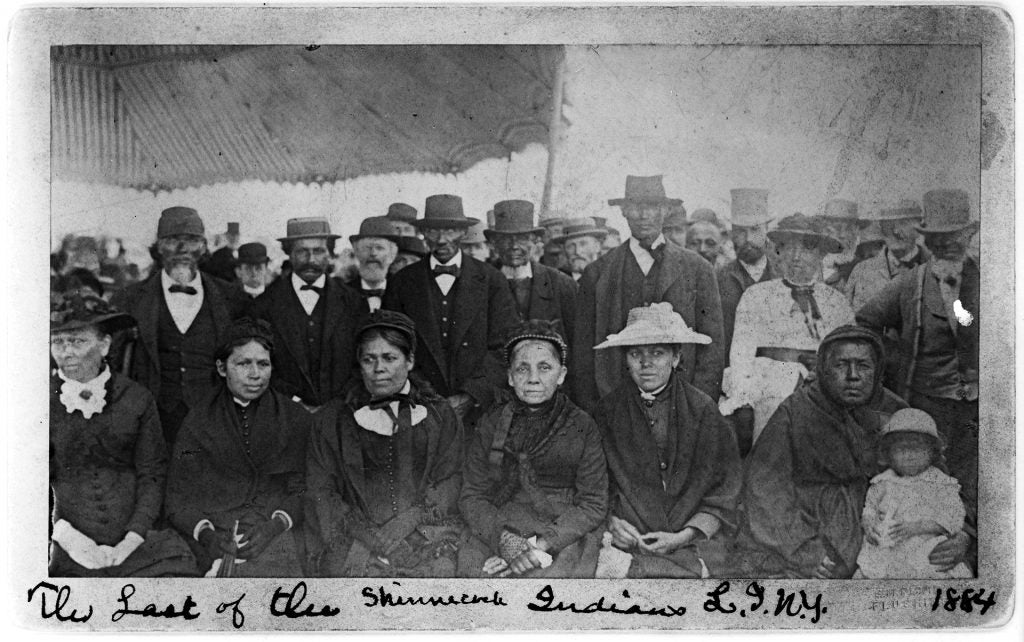
Shinnecock Indians, 1884, Long Island Rail Road, Front row-L-R: Frances Bunn, Anna Bunn Kellis, Mary Brewer, “Grandma O” or unidentified, Harriet Walker Hudson. Back row L-R: Possibly Luther Bunn, Joshua Kellis, James Bunn, Unidentified, Possibly Wickham Cuffee, Unidentified. The caption reads, "The Last of the Shinnecock Indians" which was part of the common vanishing race myth that justified colonization and land theft. The romanticism that Indigenous people were either doomed to dying out or assimilating and therefore the stolen lands were now inevitably vacant. Photo Courtesy of On the Site, Founded by Jeremy Dennis (Shinnecock).
The Doctrine of Discovery was a practice that gave colonizing Europeans title to previously “undiscovered” Indigenous lands. The land title was considered completed if the discovering colonizing power took possession of the land. How has this title been completed if, more than 500 years later, the original inhabitants—in this case, the Shinnecock People—are still in possession of the land? The Shinnecock hold what is called “Aboriginal title.” Unlike other jurisdictions, the content of Aboriginal title is not limited to historical or traditional land uses. Aboriginal title is distinct from the lands that Native Americans own in fee simple (meaning the land is owned outright and without restrictions) and occupy under federal trust. The Shinnecock People have not been removed from their ancestral homelands and still live on the land. So, how has the title of the land been completed by the first representatives of England when the Shinnecock People have continually inhabited it? It was never ceded to England, nor Plymouth Colony, Connecticut, New Amsterdam, New York, and certainly not Southampton Village.
Despite the Shinnecock’s continued inhabitance of the land, Southampton's perpetuation of the Doctrine of Discovery continues to manifest in various ways, such as land use, development, and resource extraction, that do not fully respect the sovereignty and rights of the Shinnecock People over their ancestral lands. This includes zoning laws, property disputes, and other policies that marginalize the Shinnecock People and restrict their ability to exercise full control over their traditional territories.
Giving a prayer to help heal the traumas that have been ongoing on the Indigenous Peoples of Long Island at the Hawthorne Unearthing site. This was during the Shinnecock Pow Wow Weekend 2018. Photo by Brian Dow.
The following timeline highlights a few of the laws and other legal documents since the Doctrine of Discovery:
1493 - Doctrine of Discovery gives the Europeans the right to dominion over all life in the so-called lands of discovery. The English monarchy’s representatives laid claim to North America as early as 1497, just four years after the Doctrine of Discovery.
1496 - King Henry VII grants a patent to Italian explorer John Cabot
1497 - John Cabot sails from Bristol, England and lays claim to what is known today as Newfoundland
1524 - Giovanni da Verrazzano, just before he spent 15 days in Narragansett territory (a sister Tribe of the Shinnecock People), encountered the people on the east end of Long Island. He would later describe the encounter: “We reassured them with various signs, and some of them came up, showing great delight at seeing us and marveling at our clothes, appearance, and our whiteness...They are dark, not unlike the Ethiopians, with thick black hair, not very long, tied back behind the head like a small tail.”
1621 - Treaty of Plymouth is signed by Governor John Carver and Massasoit
1636 - King Charles I informs Plymouth Colony that the English have laid claim to all of Long Island
1638 - Pequot Massacre: More than 400 Pequots were murdered, and any survivors were either killed or forced into slavery in the Caribbean or divided to be traded into indentured servitude for the settlers.
1639 - James Farret, acting as an agent for William Alexander, Earl of Stirling, receives a patent to the Long Island territory from King Charles I.
1640 - So-called “Indian Deed of Southampton” is created by the first settlers of Southampton and includes the names of Shinnecock people. Tribal members have argued over the years that our ancestors did not know what they were signing.
1643 - Plymouth Colony, Massachusetts Bay Colony, Connecticut Colony, and New Haven Colony formed the New England Confederation, known as the four united colonies, which belonged to the Dominion of New England.
1640s - Miantonomi visits Montauk to form a new alliance with New England and Long Island Tribes
1650s-1670s - Many laws between Plymouth Colony and Long Island are created with harsh punishments to Indians
1660 - King Charles II becomes the King of England
1663 - John Elliot translates the Bible into Algonquin with the help of Long Island Native inhabitants
1664 - Quashawam, the daughter of Wyandanch, becomes the great sachem and is recognized in Southampton as the new sachem on February 11, 1664
1665 - The Duke of York’s Laws are established, notably including: “No Purchase of lands from Indians After the first day of March 1604, shall be Esteemed a good Title…”
1670 - Governor Richard Nicolls issues a commission to the Shinnecock Peoples to choose a single leader, and Chief/Sachem Quaquashawg is appointed by the Shinnecock and approved by the governor of New York. However, the Village of Southampton had previously installed Quashawam, the daughter of Wyandanch, as a great sachem. In January 1670, Governor Nicolls forced the Shinnecock to follow only one leader, leading the Shinnecock community and colonial villagers to ignore Quashawam’s leadership. No trace was ever found of Quashawam after February 11, 1664, making her an early example of the paper genocide of our leadership and our women.
1671 - New York prohibits Indians from practicing their religious rituals
1675-1678 King Philip's War
1680 - King William III becomes the King of England
1686 - The Dongan Patent is established by the Board of Trustees of the Town of Southampton giving colonists access to Shinnecock lands and waters.
1732 - The Brookhaven Town Board votes to prohibit Indians, Indian servants, and African-American slaves from traveling at night for the next three months. Anyone caught violating this ordinance would be publicly whipped.
1760 - King George III becomes the King of England
1776 - The United States is formed, known then as the 13 Colonies
1792 - Southampton dismantles the traditional governing system of the Shinnecock People by not recognizing the Tribe’s elected leadership and requires the Tribe to vote for a three-man trustee system. This vote, and all other meetings by Shinnecock People related to the trustee system, are mandated to be held in the Village.
1823 - In a landmark Supreme Court decision, Johnson v. McIntosh, the court holds that Indians cannot sell land, affirming one the Duke of York’s Laws from 1664.
1831 - The New York state legislature establishes the Shinnecock School, a schoolhouse built on Shinnecock territory with state-appointed teachers to educate Shinnecock students.
1860 - The Village of Southampton votes to fence Shinnecock people in on the lands in which they reside. Today, Shinnecock territory has three roads leading into the territory: East Gate Road, Middle Gate Road, and West Gate Road. These roads are named for the fences around the territory.
1990 - Shinnecock men are sued for cutting trees for firewood in their ancestral homelands
1992 - Shinnecock re-establish Tribal governance by forming a 13-member Tribal Council.
1993 - Shinnecock women regain the right to vote within the Tribe for the first time since their exclusion by the village of Southampton in 1792.
2003 - Human remains dating between 1400-1640 CE are discovered on Shelter Island during the construction of a private residence. Despite protests by Long Island Tribes to halt the construction following the discovery, development continued.
2014 - The Shinnecock discontinue the 13-member Tribal Council and replace it with a 7-member Council of Trustees, which remains the system currently in use.
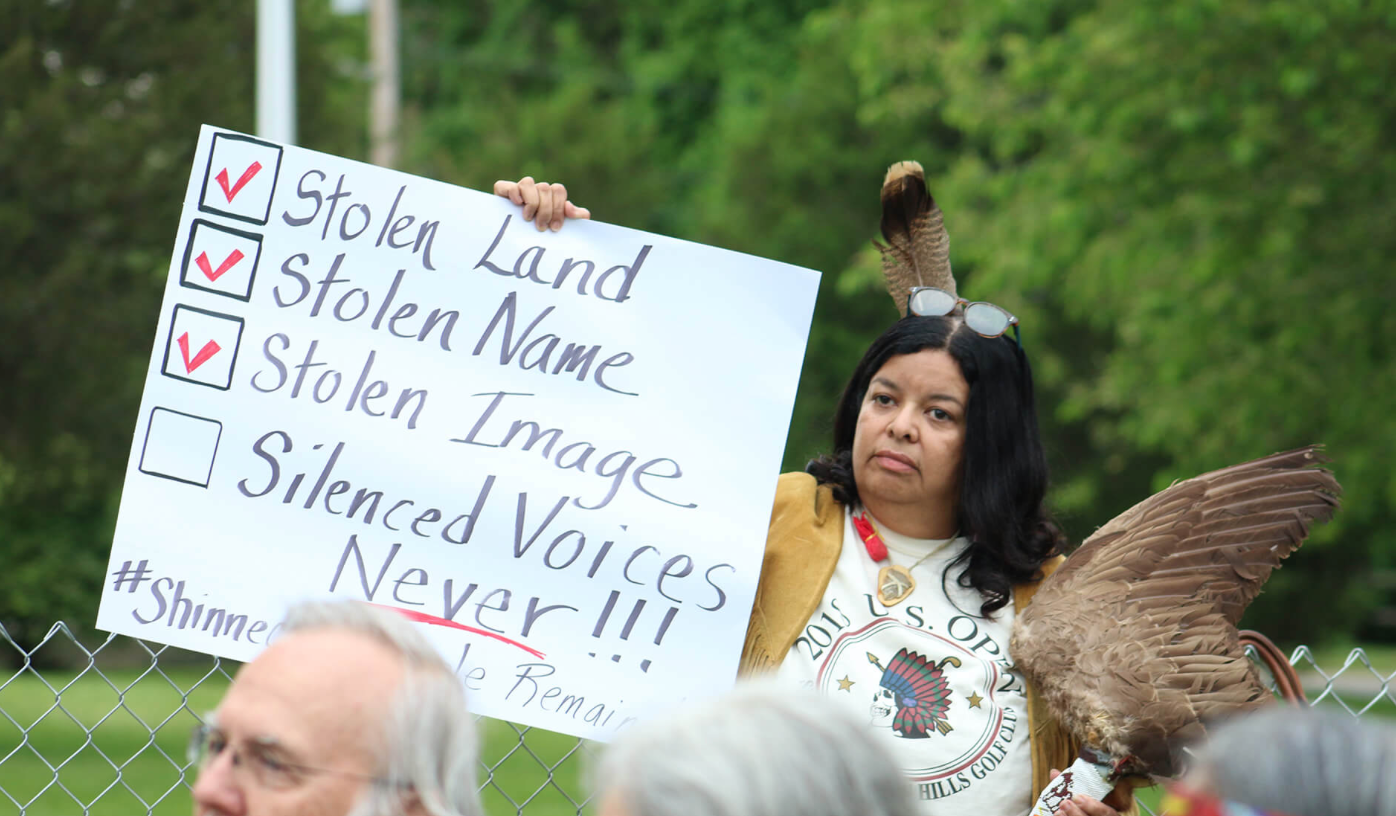
Photo of Denise Silva-Dennis known as Weetomo at a Rally for the continued theft of the Shinnecock Hills. Photo courtesy of Southampton Press.
The legal fiction of the Indian Deed of December 13, 1640, created by the Town of Southampton, lies in the discrepancy between the European legal concept of land ownership and the traditional Indigenous understanding of land use and stewardship, as well as the questionable circumstances under which the deed was obtained. The Deed, and the Doctrine of Discovery, are considered invalid due to several factors:
- Unequal Bargaining Power: The deed was created during a time when the concept of fair and equal bargaining between the European settlers and the Indigenous people was virtually non-existent. The power dynamics heavily favored the settlers, leading to an inherently unfair agreement.
- Lack of Full Understanding: There is significant doubt regarding whether the Indigenous signatories fully understood the implications of the document, including the concept of land ownership as perceived by the European settlers. This raises questions about the validity of their consent.
- Contradiction with Indigenous Land Practices: The document clashes with the traditional Indigenous land tenure and governance systems. Our cultural lifeways often included moving throughout the year to seasonal locations. In the eyes of the Europeans, the land was abandoned, as it imposed a foreign understanding of land ownership onto a society with different conceptions of land use and ownership.
- Coercive Factors: There are historical indications that the deed of 1640 and similar agreements during the first contact period were often obtained under duress, coercion, or through the use of asymmetrical power dynamics.
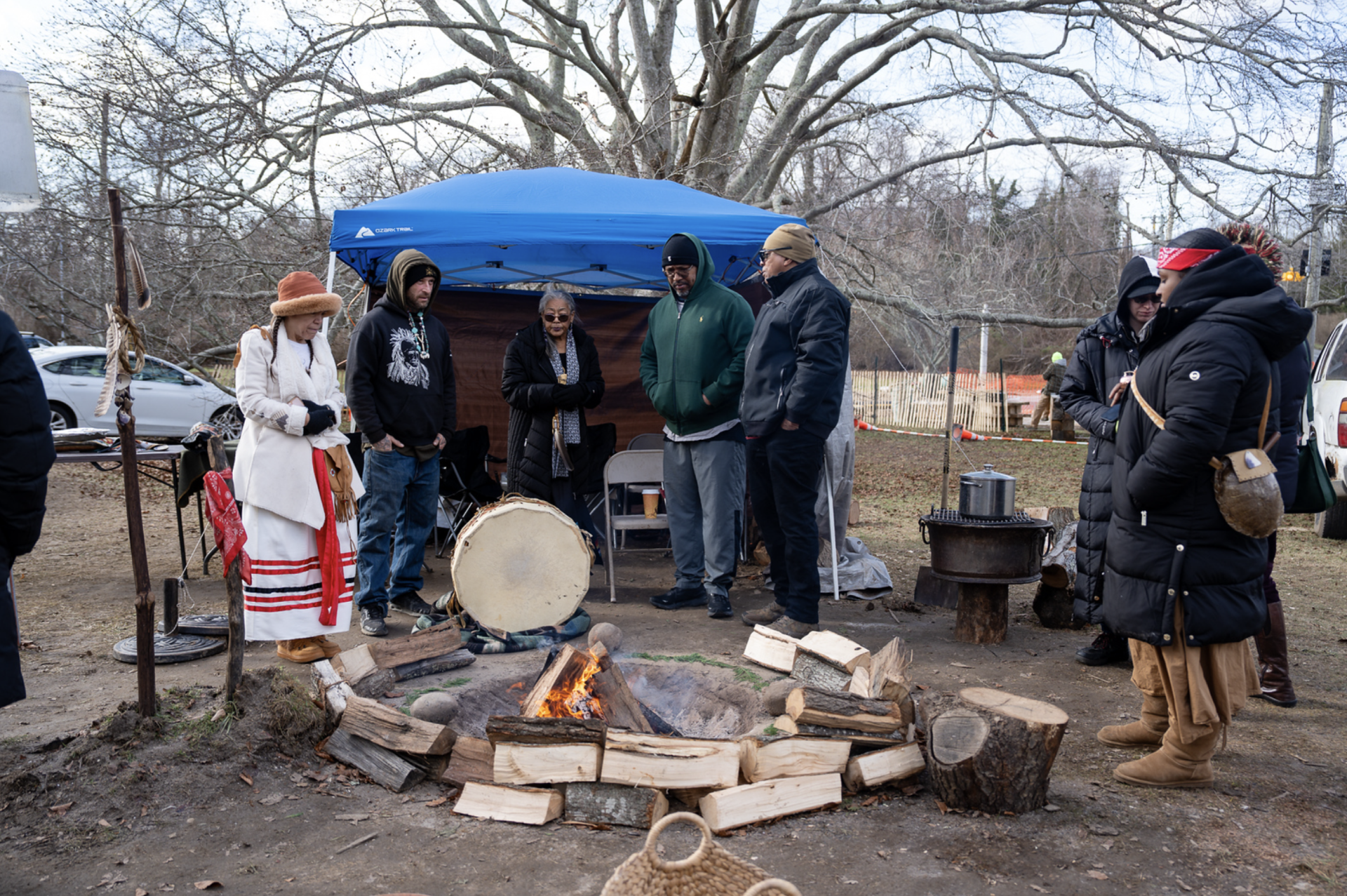
Tobacco Prayer at the foot of the hill on East Gate road at the prayer fire that has been lit for nearly 30 days since tribal citizens' presence has halted National Grid construction on completing their gas pipeline.
The Shinnecock, and all of the other first contact Tribes, have Tribal laws that predate the Doctrine of Discovery. The harmful impact of the Doctrine of Discovery can be seen in the laws that have been enacted against the traditional practices of Indigenous Peoples. These laws fail to recognize or acknowledge any pre-existing Indigenous laws, further perpetuating the damaging effects of the Doctrine of Discovery. In 1823, Chief Justice John Marshall referenced the Doctrine of Discovery in the Johnson vs. McIntosh decision. His opinion was that the Right of domination was inherently held by the Europeans, giving them the right to dominate Indigenous Peoples. This clearly raises significant concerns about the doctrine’s legal and moral validity.
Centuries later, the Shinnecock people are actively fighting to prevent additional land seizures from occurring in their homelands. Honor the Earth, a nonprofit organization that raises awareness and financial support for Indigenous environmental justice, calls this “Green Colonialism.” In a recent Instagram post, @Honor the Earth condemned the “Newest frontier of settler colonization on Turtle Island. Many so-called ‘green’ projects offer false solutions to the climate crisis. Many ‘green’ projects involve rampant extraction of natural resources, land grabs, displacement of Indigenous Peoples, and imposition of colonial conservation without respecting Indigenous knowledge, needs, rights, sovereignty, or Free, Prior and Informed Consent.”
Chenae Bullock holding a sign at what is now 57 Montauk Highway. During the continued construction on sacred burial grounds known as Shinnecock Hills. Photo by Kayla Lookinghorse-Smith (Lakota).
National Grid, a gas company, has built infrastructure for a natural gas shut-off valve that was permitted by Southampton Village on the ancestral homelands where the Shinnecock Peoples reside without their knowledge or consent. On December 30, 2023, members of the Shinnecock community went to where the destruction of the land was taking place and asked National Grid to stop. They agreed to halt construction while Southampton Village and the Shinnecock Nation resolve the discrepancy. The mayor of Southampton has informed our Tribal leadership the town purchased the land years ago and intends to furnish proof that the Town holds the title.
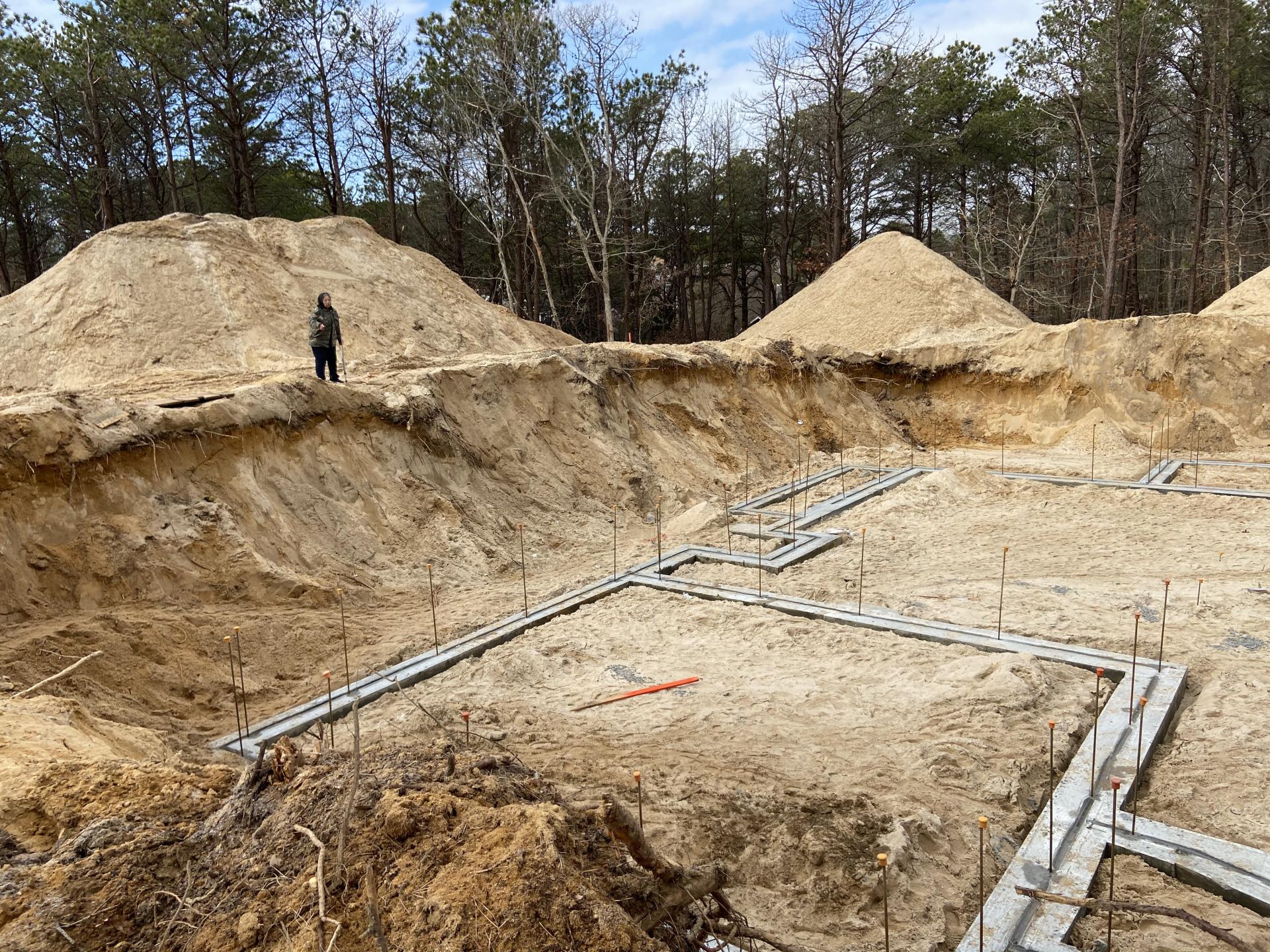
Private development dig in our Sacred Shinnecock Hills. Rebecca Geina standing over it praying for the protection of our ancestors have have been desecrated. Photo by Chenae Bullock.
Many of the colonial villages that were established on the lands of Indigenous Peoples have broken their contracts with the original Peoples. Since the 1700s, they have created laws that made it illegal for the original inhabitants to use their lands. They have stripped our children away, putting them into indentured servitude, and forced our men into wars against other Indigenous Peoples. The physical, mental, sexual, and emotional abuse and trauma suffered by generations has taken a toll on our spirits, and the social ills stemming from the assertion of colonialism on our cultural practices continue to have systemic effects on how we think and operate in society, contributing to the emotional and spiritual disorientation of an entire People.
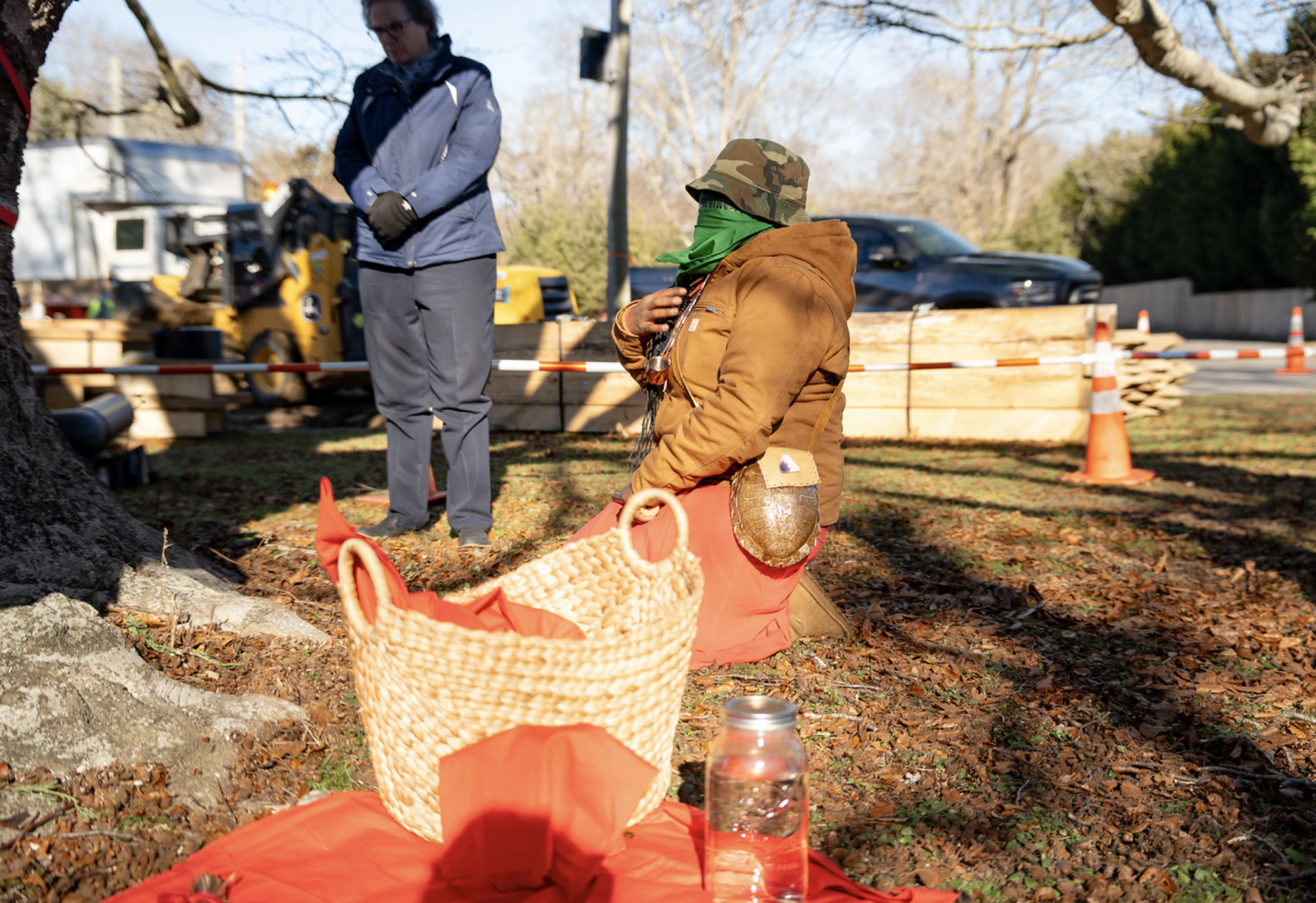
Putting prayers down at the foot of the hill on East Gate Road where Nation Grid has attempted to complete their gas shut-off valve. Photo by Rebekah Phoenix Wise (Shinnecock).
CALL TO ACTION:
Share this article with Southampton Village officials
Call/Write/Email/DM
Southampton Village Mayor 631-283-9247 X 222
kbontempo@southamptonvillage.org
Southampton Public Works 631-283-4269
Demand they resend the permit, acknowledge Shinnecock lands, and correct the maps they use.
Call/Write/Email/DM
National Grid 1-800-930-5003
Demand they reroute their pipeline and restore Shinnecock land to its natural order
VISIT www.moskehutconsulting.com
FOLLOW @netooeusqua
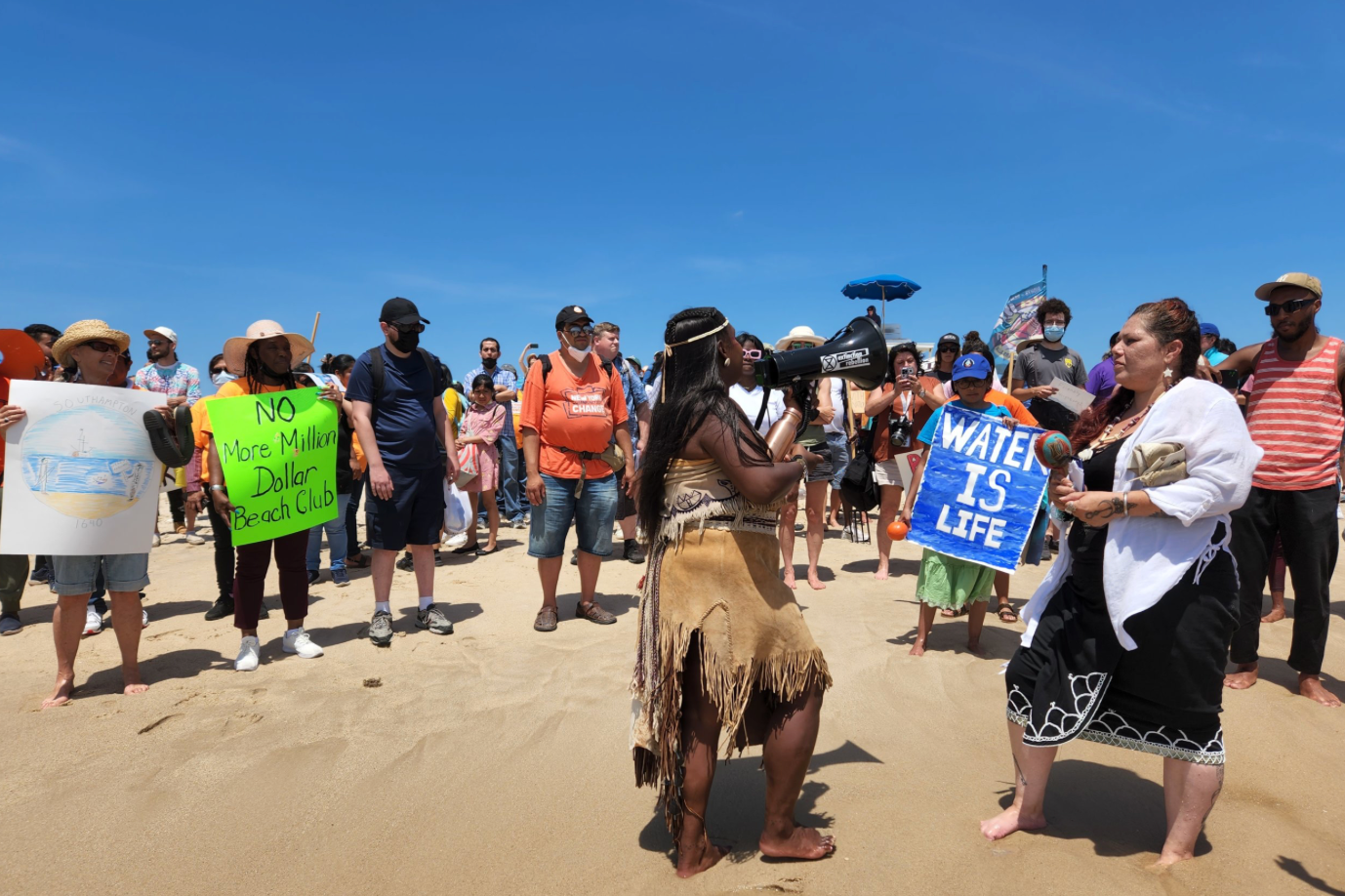
Shinnecock Ocean Access rally and prayer at Coopers Beach in 2021. Chenae Bullock with Rainbow Chavis, Shinnecock Cultural Resources Department Director. We are living descendants of those who have been living in Shinnecock homelands since time immemorial. Photo by Jeremy Dennis (Shinnecock).
— Chenae Bullock is an enrolled Shinnecock Indian Nation Tribal member and descendant of the Montauk Tribe in Long Island, New York. She is a community leader, water protector, cultural preservationist, Indigenous perspective historian, and humanitarian. She is also the founder and CEO of Moskehtu Consulting, LLC, and a Cultural Survival Writer in Residence.
Top photo: Shinnecock Graves Protection Warrior Society with IPDNYC Co-Founder Cliff Matias and Reddrum Motorcycle Club. Photo by Chenae Bullock.


